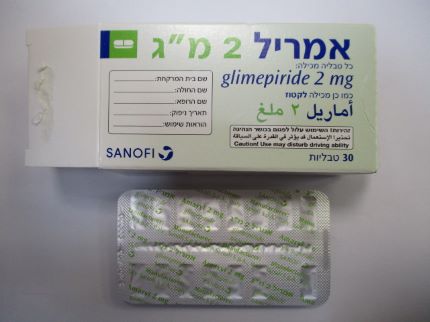Quest for the right Drug

אמריל 2 מ"ג AMARYL 2 MG (GLIMEPIRIDE)
תרופה במרשם
תרופה בסל
נרקוטיקה
ציטוטוקסיקה
צורת מתן:
פומי : PER OS
צורת מינון:
טבליה : TABLETS
עלון לרופא
מינוניםPosology התוויות
Indications תופעות לוואי
Adverse reactions התוויות נגד
Contraindications אינטראקציות
Interactions מינון יתר
Overdose הריון/הנקה
Pregnancy & Lactation אוכלוסיות מיוחדות
Special populations תכונות פרמקולוגיות
Pharmacological properties מידע רוקחי
Pharmaceutical particulars אזהרת שימוש
Special Warning עלון לרופא
Physicians Leaflet
Adverse reactions : תופעות לוואי
7. ADVERSE REACTIONS The following serious adverse reactions are discussed in more detail below and elsewhere in the labeling: • Hypoglycemia [see Warnings and Precautions (5.1)] • Hemolytic anemia [see Warnings and Precautions (5.3)] 7.1 Clinical Trials Experience Because clinical trials are conducted under widely varying conditions, adverse reaction rates observed in the clinical trials of a drug cannot be directly compared to rates in the clinical trials of another drug and may not reflect the rates observed in practice. Approximately 2,800 patients with type 2 diabetes have been treated with AMARYL in the controlled clinical trials. In these trials, approximately 1,700 patients were treated with AMARYL for at least 1 year. In clinical trials, the most common adverse reactions with AMARYL were hypoglycemia, dizziness, asthenia, headache, and nausea. Table 1 summarizes adverse events, other than hypoglycemia, that were reported in 11 pooled placebo-controlled trials, whether or not considered to be possibly or probably related to study medication. Treatment duration ranged from 13 weeks to 12 months. Terms that are reported represent those that occurred at an incidence of ≥5% among AMARYL-treated patients and more commonly than in patients who received placebo. Table 1. Eleven Pooled Placebo-Controlled Trials ranging from 13 weeks to 12 months: Adverse Events (Excluding Hypoglycemia) Occurring in ≥5% of AMARYL-treated Patients and at a Greater Incidence than with Placebo* AMARYL Placebo N=745 N=294 % % Headache 8.2 7.8 Accidental Injury† 5.8 3.4 Flu Syndrome 5.4 4.4 Nausea 5.0 3.4 Dizziness 5.0 2.4 * *AMARYL doses ranged from 1-16 mg administered daily †Insufficient information to determine whether any of the accidental injury events were associated with hypoglycemia Hypoglycemia: In a randomized, double-blind, placebo-controlled monotherapy trial of 14 weeks duration, patients already on sulfonylurea therapy underwent a 3-week washout period then were randomized to AMARYL 1 mg, 4 mg, 8 mg or placebo. Patients randomized to AMARYL 4 mg or 8 mg underwent forced-titration from an initial dose of 1 mg to these final doses, as tolerated [see Clinical Studies (14.1)]. The overall incidence of possible hypoglycemia (defined by the presence of at least one symptom that the investigator believed might be related to hypoglycemia; a concurrent glucose measurement was not required) was 4% for AMARYL 1 mg, 17% for AMARYL 4 mg, 16% for AMARYL 8 mg and 0% for placebo. All of these events were self- treated. In a randomized, double-blind, placebo-controlled monotherapy trial of 22 weeks duration, patients received a starting dose of either 1 mg AMARYL or placebo daily. The dose of AMARYL was titrated to a target fasting plasma glucose of 90-150 mg/dL. Final daily doses of AMARYL were 1, 2, 3, 4, 6 or 8 mg [see Clinical Studies (14.1)]. The overall incidence of possible hypoglycemia (as defined above for the 14-week trial) for AMARYL vs. placebo was 19.7% vs. 3.2%. All of these events were self-treated. Weight gain: AMARYL, like all sulfonylureas, can cause weight gain [see Clinical Studies (14.1)]. Allergic Reactions: In clinical trials, allergic reactions, such as pruritus, erythema, urticaria, and morbilliform or maculopapular eruptions, occurred in less than 1% of AMARYL-treated patients. These may resolve despite continued treatment with AMARYL. There are postmarketing reports of more serious allergic reactions (e.g., dyspnea, hypotension, shock) [see Warnings and Precautions (5.2)]. Laboratory Tests: Elevated Serum Alanine Aminotransferase (ALT): In 11 pooled placebo-controlled trials of AMARYL, 1.9% of AMARYL-treated patients and 0.8% of placebo-treated patients developed serum ALT greater than 2 times the upper limit of the reference range. 7.2 Postmarketing Experience The following adverse reactions have been identified during postapproval use of AMARYL. Because these reactions are reported voluntarily from a population of uncertain size, it is not always possible to reliably estimate their frequency or establish a causal relationship to drug exposure. • Serious hypersensitivity reactions, including anaphylaxis, angioedema, and Stevens- Johnson Syndrome [see Warnings and Precautions (5.2)] • Hemolytic anemia in patients with and without G6PD deficiency [see Warnings and Precautions (5.3)] • Impairment of liver function (e.g. with cholestasis and jaundice), as well as hepatitis, which may progress to liver failure. • Porphyria cutanea tarda, photosensitivity reactions and allergic vasculitis. • Leukopenia, agranulocytosis, aplastic anemia, and pancytopenia. • Thrombocytopenia: (including severe cases with platelet count less than 10,000/µl) and thrombocytopenic purpura. • Hepatic porphyria reactions and disulfiram-like reactions • Hyponatremia and syndrome of inappropriate antidiuretic hormone secretion (SIADH), most often in patients who are on other medications or who have medical conditions known to cause hyponatremia or increase release of antidiuretic hormone • Dysgeusia • Alopecia Reporting of suspected adverse reactions Reporting suspected adverse reactions after authorisation of the medicinal product is important. It allows continued monitoring of the benefit/risk balance of the medicinal product. Any suspected adverse events should be reported to the Ministry of Health according to the National Regulation by using an online form at https://sideeffects.health.gov.il/.

פרטי מסגרת הכללה בסל
התרופה תינתן לטיפול בסוכרת סוג 2.
מסגרת הכללה בסל
התוויות הכלולות במסגרת הסל
| התוויה | תאריך הכללה | תחום קליני | Class Effect | מצב מחלה |
|---|---|---|---|---|
| התרופה תינתן לטיפול בסוכרת סוג 2. |
שימוש לפי פנקס קופ''ח כללית 1994
לא צוין
תאריך הכללה מקורי בסל
15/01/2015
הגבלות
תרופה מוגבלת לרישום ע'י רופא מומחה או הגבלה אחרת
מידע נוסף
